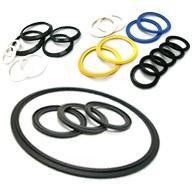
In the food, beverage and related industries there are a significant number of areas where two stainless steel pieces must be sealed. Elastomers are the materials used to seal these areas of sanitary process equipment and components. Elastomers are used in:
By definition, an elastomer is a polymer with the property of viscoelasticity (elasticity). Polymers are made up of monomers; primarily carbon, hydrogen, oxygen and/or silicon. These monomers become a long chain of (cross linked) polymers during the elastomer curing process.

Crosslinking plays a critical role in an elastomers’ ability to successfully seal and prevent unwanted leaks. There are a variety of stresses that elastomers encounter within sanitary process environments including pressure, temperature, and chemical. The key for elastomers being able to effectively seal is their ability to return to their original shape following these stresses. Without crosslinking, the applied stress would result in permanent deformation, causing seal failures and unwanted leaks.
The ability of an elastomer to return to its original shape following environmental stresses is called elastomer memory. Memory is only one key factor critical for elastomer manufacturers and end users.
Durometer, or the hardness of the elastomer compound, along with elasticity, how much a piece can stretch prior to breaking the polymer, are also crucial factors for successful sealing of sanitary process components.
Trusted elastomer manufacturers have perfected production methods required for effective leak prevention. Keep your process leak free with the right elastomer partner. Keep these questions in mind when shopping for elastomers for your sanitary process.
Rodem has partnered with some of the best known elastomer manufacturers in the business. See our selection of gaskets, o-rings and orifice plates. Contact your Rodem representative to learn more about the elastomers for your sanitary process.
E-mail: [email protected]
Copyright 2024 Rodem Inc. All rights reserved.
